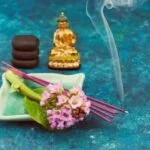Aromatherapy is a holistic practice that utilizes the power of scent to promote physical, emotional, and mental well-being. Aromatherapy oils, also known as essential oils, are highly concentrated plant extracts that capture the therapeutic properties and aromatic essence of various plants.
These oils are used in a multitude of ways to enhance relaxation, alleviate stress, improve sleep quality, boost mood, and address specific health concerns. In this article, we will explore the different methods of using aromatherapy oils and delve into their numerous benefits.
Aromatherapy has been practiced for centuries and is believed to have originated in ancient Egypt. It has since gained popularity worldwide as a natural and effective way to improve overall wellness. Aromatherapy oils have unique chemical compositions that can affect our body’s physiological responses when inhaled or applied topically. The scents from these oils can stimulate certain receptors in our brain, triggering emotional and hormonal responses that contribute to relaxation or invigoration, depending on the specific oil used.
There are several reasons why individuals turn to aromatherapy oils as part of their self-care routines. Not only do they offer a pleasant sensory experience through their delightful fragrances, but they also provide potential therapeutic effects.
Whether you are seeking relief from stress or anxiety, improved sleep quality, rejuvenation for your skin or hair, or assistance with respiratory issues, aromatherapy oils may be able to help you achieve your desired outcomes naturally and holistically. By incorporating these oils into your daily life, you can create a calming and soothing environment that promotes balance and well-being for both your body and mind.
Understanding Aromatherapy Oils
Aromatherapy oils, also known as essential oils, are highly concentrated plant extracts that have been used for centuries for their therapeutic properties. Each oil has its own unique scent and specific benefits, making it important to understand the different types of aromatherapy oils available and how they can be used to promote overall well-being.
There are numerous types of aromatherapy oils, each derived from different plants and possessing distinct therapeutic properties. Some popular examples include lavender, tea tree, eucalyptus, peppermint, chamomile, and lemon. Lavender oil is commonly used for its calming and relaxing effects, while tea tree oil is known for its natural antiseptic properties.
Eucalyptus oil is often used to alleviate respiratory issues such as congestion, while peppermint oil can provide relief from headaches. Chamomile oil is well-regarded for its soothing abilities and lemon oil is commonly used for its uplifting and invigorating qualities.
The benefits of aromatherapy oils extend beyond just pleasant scents. These natural extracts have been found to have various therapeutic effects on the mind and body. For example, inhaling certain scents can help reduce stress levels, improve sleep quality, boost cognitive function and memory retention, alleviate pain or discomfort, enhance mood and relaxation, alleviate allergies or sinus congestion, promote healthy skin conditions like acne or inflammation reduction among many other benefits depending on the specific type of oil used.
Safety Precautions
Understanding the Potency of Aromatherapy Oils
When using aromatherapy oils, it is important to understand that they are highly concentrated substances and should be handled with care. Aromatherapy oils are extracted from various plants and contain potent compounds that give them their therapeutic properties. However, this also means that they can cause harm if not used properly.
Patch Testing for Allergies
Before using any new aromatherapy oil on your skin, it is recommended to perform a patch test to check for any potential allergic reactions. To do this, dilute a small amount of the oil in a carrier oil (such as jojoba or sweet almond oil) and apply it to a small area of your forearm.
Leave it on for 24 hours and observe if there are any adverse reactions such as redness, itching, or inflammation. If you experience any of these symptoms, it is best to avoid using that particular oil.
Avoiding Certain Essential Oils during Pregnancy
It is important to note that some essential oils may not be safe to use during pregnancy. Certain oils have hormonal effects or may stimulate contractions, which can be harmful during pregnancy. It is recommended to consult with a healthcare professional before using any aromatherapy oils if you are pregnant or breastfeeding.
Diluting Essential Oils Properly
Aromatherapy oils should always be diluted before applying them topically. Since they are highly concentrated, direct application can cause skin irritation or other adverse reactions. The recommended dilution ratio is typically 2-5% essential oil in a carrier oil or cream. This means adding approximately 10-25 drops of essential oil per ounce of carrier substance.
Proper Storage and Handling
To maintain the potency and shelf life of your aromatherapy oils, it is important to store them properly. Most essential oils should be kept in dark glass bottles away from direct sunlight and extreme temperatures. Additionally, ensure that the lids are tightly closed to prevent oxidation. Remember to keep your oils out of reach of children and pets.
By following these essential guidelines for using aromatherapy oils, you can enjoy their benefits safely and effectively. Taking the necessary precautions will help ensure a positive experience with aromatherapy and minimize the risk of any adverse reactions or accidents.
Choosing the Right Aromatherapy Oils
When it comes to selecting aromatherapy oils, there are several factors that you should consider. Understanding these factors will help you choose the right oils for your specific needs and preferences. The following subsections will outline some important considerations when choosing aromatherapy oils.
Purity and Quality
One of the most crucial factors to consider when choosing aromatherapy oils is their purity and quality. It’s important to select oils that are pure and free from any additives or synthetic substances. Look for oils that are labeled as “pure,” “organic,” or “therapeutic grade.” These designations indicate that the oil is of high quality and has been extracted using proper methods.
Scents and Properties
Each aromatherapy oil has its own distinct scent and properties, which can have different effects on the mind and body. Some oils, such as lavender and chamomile, have calming properties that promote relaxation and sleep. Others, like peppermint and eucalyptus, have invigorating properties that enhance focus and energy. Consider the desired effects you want to achieve before selecting an oil with the appropriate scent and properties.
Personal Preferences
Everyone has their own personal preferences when it comes to scents. Some people may find certain aromatherapy oils more pleasing than others. It’s important to choose oils that you enjoy inhaling or applying topically, as this enhances the overall experience of using aromatherapy oils. Experiment with different scents to find what resonates best with you.
Contraindications
Before using any aromatherapy oil, it’s essential to check for any contraindications or potential risks. Some oils may interact with medications or have adverse effects on certain individuals, such as pregnant women or people with certain medical conditions. It’s recommended to consult with a qualified aromatherapist or healthcare professional to ensure the safe use of aromatherapy oils.
By considering factors such as purity and quality, scents and properties, personal preferences, and contraindications, you can confidently choose the right aromatherapy oils for your needs. Remember to always store your oils properly in a cool, dark place to maintain their potency and effectiveness. In the next sections of this article, we will explore different methods of using aromatherapy oils and how they can benefit you in various aspects of your life.
Methods of Using Aromatherapy Oils
Inhalation is one of the most common and effective methods of using aromatherapy oils. By inhaling the scents of these oils, the therapeutic properties are quickly absorbed into the body, providing various benefits depending on the specific oil used. There are several inhalation techniques that can be employed to experience the effects of aromatherapy oils.
One simple method is through direct inhalation. This involves placing a few drops of the desired oil onto a tissue or cotton ball and holding it near the nose. Take slow, deep breaths to fully inhale the scent. This technique is convenient and can be done anytime, anywhere.
Another popular method is steam inhalation. It is not only an effective way to enjoy aromatherapy oils but also a great remedy for respiratory congestion and sinus issues. To do this, add a few drops of oil to a bowl of hot water. Lean over the bowl with a towel draped over your head, creating a tent-like structure that helps trap and direct the steam towards your face. Close your eyes and breathe deeply for about 5-10 minutes.
For those who prefer a more subtle approach, using an aroma diffuser is recommended. Diffusers disperse microscopic particles of essential oils into the air, allowing you to inhale them effortlessly. These devices provide ongoing diffusion and are perfect for creating a calming ambience in your home or office space.
It’s important to note that different oils have different properties, so choose an inhalation technique based on your needs. For relaxation and stress relief, lavender or chamomile oil may be best suited for you. On the other hand, peppermint or eucalyptus oil might be more effective for promoting focus and mental clarity.
Overall, inhalation techniques offer a convenient way to enjoy aromatherapy oils and experience their benefits. Whether you choose direct inhalation, steam inhalation, or aroma diffusers, incorporating these methods into your daily routine can bring a sense of calm and well-being to your life.
Topical Applications
When it comes to using aromatherapy oils, topical applications offer a variety of methods to experience their benefits. Massages, bathing, and compresses are all effective ways to enjoy the therapeutic properties of these oils.
One popular method of using aromatherapy oils topically is through massages. Adding a few drops of your chosen oil to a carrier oil, such as sweet almond or coconut oil, can create a soothing massage blend.
The combination of the massage itself with the aromatic properties of the oils helps relax tense muscles, reduce stress, and promote overall well-being. Additionally, certain essential oils like lavender or chamomile have calming properties that can aid in sleep and relaxation when used during a massage.
Another way to incorporate aromatherapy oils into your daily routine is through bath time. Adding a few drops of essential oils to your bathwater can transform an ordinary bath into a luxurious and therapeutic experience. Not only do the scents help create a calming atmosphere, but they can also provide numerous benefits depending on the oil used. For example, adding eucalyptus oil can help relieve congestion during colds or allergies, while adding rosemary oil may improve mental clarity and focus.
Compresses are yet another effective method for topical application of aromatherapy oils. A compress involves soaking a washcloth or towel in water infused with essential oils and applying it to specific areas of the body. This technique allows for localized treatment and is particularly useful for relieving headaches, muscle pain, swelling, or menstrual cramps. Depending on the desired effect and targeted area, different essential oils can be used for compresses.
Using aromatherapy oils topically not only offers physical benefits but also brings about emotional support and relaxation. Before using any essential oil directly on the skin or in baths or compresses, it’s important to perform a patch test to check for any allergic reactions or sensitivities. It’s also crucial to dilute essential oils properly to avoid skin irritation.
Creating a Calming Environment
Aromatherapy diffusers are a popular and effective way to create a calming environment using essential oils. These devices not only disperse fragrant scents into the air, but they also have therapeutic benefits for physical and emotional well-being. Here are some different methods of using aromatherapy oils in diffusers:
- Ultrasonic Diffusers: These diffusers use water and ultrasonic vibrations to create a fine mist that carries the aroma of the essential oils into the air. They are easy to use and often come with adjustable settings for mist intensity and run time. Ultrasonic diffusers are excellent for larger spaces as they can effectively cover a wider area.
- Nebulizing Diffusers: Unlike ultrasonic diffusers, nebulizing diffusers do not require water or heat to release the aromatic molecules of essential oils. Instead, they use pressurized air or gas to atomize the oil into tiny particles that are dispersed directly into the air. This method maintains the integrity of the oil’s therapeutic properties and allows for maximum scent diffusion.
- Reed Diffusers: Reed diffusers consist of a container filled with essential oil mixed with a carrier oil, such as sweet almond oil or jojoba oil, and several reeds placed in it. The reeds absorb the mixture and then release the fragrance into the surrounding area through capillary action. This method provides a constant slow release of scent over a more extended period.
When using aromatherapy oils in diffusers, it’s important to consider safety precautions:
- Use high-quality, pure essential oils that are specifically labeled for aromatherapy or therapeutic use.
- Follow manufacturer instructions regarding dilution ratios if required.
- Keep diffusers out of reach of children and pets.
- Place diffusers on stable surfaces away from flammable materials.
- Clean your diffuser regularly according to manufacturer instructions.
Creating a calming environment with aromatherapy oils in diffusers has numerous benefits. The use of certain essential oils, such as lavender or chamomile, can promote relaxation and improve sleep quality. Peppermint or eucalyptus oils, on the other hand, are refreshing and invigorating, making them perfect for creating an energizing atmosphere. Experimenting with different scents to find the ones that work best for you is part of the joy of aromatherapy.
Blending Aromatherapy Oils
Blending aromatherapy oils is a wonderful way to create personalized scents and recipes that suit your specific needs and preferences. Whether you want to relax, uplift your mood, or alleviate certain health issues, blending oils allows you to customize the therapeutic effects of aromatherapy according to your individual requirements. Here are some tips and guidelines for blending aromatherapy oils effectively:
- Know the properties of different oils: Before you start blending, it’s important to understand the properties of each essential oil. Some oils have relaxing and soothing effects, while others are stimulating or energizing. Each oil has its own unique scent and therapeutic benefits. By familiarizing yourself with the characteristics of different oils, you can choose those that complement each other and work synergistically.
- Start with a base note, middle note, and top note: When creating a blend, it’s helpful to include oils from each category – base notes, middle notes, and top notes. Base notes provide depth and longevity to the blend, middle notes give body to the scent, and top notes provide freshness and upliftment. Combining oils from these three categories will result in a well-balanced aroma.
- Use carrier oils when necessary: To dilute the essential oils and ensure safe application on the skin or in bath products, carrier oils are often used in blends. Carrier oils also help in extending the life of the scent on the skin by slowing down evaporation. Examples of carrier oils include sweet almond oil, coconut oil, jojoba oil, or grapeseed oil.
To create your own personalized scent or blend formula:
- Begin by selecting your desired base note oil.
- Add a middle note oil that complements the base note.
- Finish by including a top note oil that adds brightness to the blend.
- Experiment with different ratios until you achieve the desired scent strength and therapeutic effect.
- If using the blend topically, dilute it with a suitable carrier oil according to recommended guidelines.
Blending aromatherapy oils is a creative and enjoyable process that allows you to tailor the benefits of aromatherapy to your specific needs. Whether you want to create a relaxing blend for bedtime or an invigorating blend for the morning, the possibilities are endless. Remember to always follow safety precautions and consult a certified aromatherapist if you have any concerns or questions about blending oils effectively.
Aromatherapy for Specific Purposes
Aromatherapy oils have been used for centuries for various purposes, including stress relief, promoting sleep, and improving skin health. These specific uses of aromatherapy oils have become increasingly popular due to their natural and holistic approach to wellness. In this section, we will explore how aromatherapy oils can be utilized for stress relief, sleep enhancement, and skincare.
- Stress Relief: When it comes to managing stress, certain aromatherapy oils have calming properties that can help alleviate anxiety and promote relaxation. Lavender oil is one of the most widely used oils for stress relief due to its soothing aroma. It can be diffused in a room or added to a carrier oil for massage therapy. Additionally, bergamot oil has been found to reduce cortisol levels (the stress hormone) when inhaled or applied topically.
- Sleep Enhancement: If you struggle with getting a restful night’s sleep, using aromatherapy oils can help create a tranquil environment that promotes relaxation and deep sleep. Essential oils such as chamomile and clary sage have sedative properties that can induce calmness and improve the quality of sleep. These oils are often incorporated into bedtime routines by adding a few drops to a diffuser or applying them topically before going to bed.
- Skincare: Aromatherapy oils also offer numerous benefits for healthy and radiant skin. Tea tree oil is well-known for its antibacterial properties, making it an excellent choice for treating acne-prone skin.
Frankincense oil has anti-aging properties and helps rejuvenate the skin by reducing the appearance of wrinkles and fine lines. Jojoba oil is another popular choice as it closely resembles the sebum produced by our skin, making it suitable even for those with oily or combination skin types.
Aromatherapy oils can be powerful tools for enhancing overall well-being when used properly and with caution. It is always recommended to consult a qualified aromatherapist or healthcare professional before using these oils, especially if you have any underlying medical conditions or sensitivities. With the right knowledge and understanding, incorporating aromatherapy oils into your self-care routine can bring about positive effects on stress relief, sleep quality, and skin health.
| Specific Purpose | Aromatherapy Oils |
|---|---|
| Stress Relief | Lavender oil, Bergamot oil |
| Sleep Enhancement | Chamomile oil, Clary sage oil |
| Skincare | Tea tree oil, Frankincense oil, Jojoba oil |
Aromatherapy Oil Safety for Children and Pets
Aromatherapy can be a wonderful practice for promoting overall well-being and relaxation, but it’s important to exercise caution when using aromatherapy oils around children and pets. While many essential oils are safe for adults, they can pose risks to young children and animals due to their sensitive systems. This section will explore the safety precautions and guidelines to follow when using aromatherapy oils around children and pets.
Safety Precautions for Children
When using aromatherapy oils around children, it’s crucial to remember that their bodies are still developing, and they may have a higher sensitivity to certain oils. Here are some key safety precautions to consider:
- Dilution: Essential oils should always be properly diluted before use on children. It is recommended to use a carrier oil such as coconut or jojoba oil when applying essential oils topically. The general rule of thumb is 1-2 drops of essential oil per ounce of carrier oil.
- Age-appropriate oils: Not all essential oils are safe for children, especially infants. For example, eucalyptus and peppermint oils should not be used on children under the age of six due to their high levels of cineole, which can cause respiratory issues. Research each specific oil before use.
- Patch test: Before applying any new essential oil blend or product to a child’s skin, it is advisable to perform a patch test first on a small area of skin to check for any potential allergic reactions or sensitivities.
Pet Safety Guidelines
Pets also require special considerations when it comes to using aromatherapy oils around them:
- Caution with cats: Cats are extremely sensitive animals, particularly when it comes to essential oils containing phenols (e.g., thyme, oregano) or monoterpene hydrocarbons (e.g., pine, citrus). These substances can be toxic to cats and should be avoided altogether.
- Proper ventilation: When diffusing essential oils in a room with pets, ensure there is proper ventilation by opening windows or using fans to prevent your pet from inhaling too much concentrated oil. Monitor their behavior and remove them from the area if they show any signs of discomfort.
- Avoid skin contact: Unless specifically recommended by a veterinarian, it is generally best to avoid applying essential oils directly to a pet’s skin. Pets have different levels of tolerance towards certain oils, and undiluted application can cause irritation or allergic reactions for some animals.
By following these safety precautions and guidelines, you can enjoy the benefits of aromatherapy while ensuring the well-being of your children and pets. However, if you have any concerns or questions about using aromatherapy oils around children and animals, it is always advisable to consult with a healthcare professional or veterinarian for personalized advice.
Frequently Asked Questions about Aromatherapy Oils
Aromatherapy has gained popularity as a natural and holistic approach to healing and wellness. As it becomes more mainstream, people have questions about the practice and the use of aromatherapy oils. In this section, we will address some frequently asked questions to provide clarity and guidance.
- What are the different types of aromatherapy oils?
- How do I choose the right aromatherapy oils?
- What are the common methods of using aromatherapy oils?
There are various types of aromatherapy oils, each with its own unique scent and properties. Some popular examples include lavender oil for relaxation, peppermint oil for headaches, tea tree oil for acne, and eucalyptus oil for respiratory issues. It’s important to note that essential oils are highly concentrated and should be used with caution.
When choosing aromatherapy oils, consider your specific needs or concerns. Research which oils are known to help with your particular issue and look for certified pure therapeutic grade (CPTG) oils from reputable brands. Additionally, personal preference plays a role in selecting an oil based on its aroma.
There are several methods for using aromatherapy oils, including inhalation techniques such as diffusing or direct inhalation, topical applications like massages or baths, and even ingestion in some cases (although this should only be done under the guidance of a trained professional).
| Frequently Asked Questions | Answers |
|---|---|
| What are the different types of aromatherapy oils? | There are various types of aromatherapy oils such as lavender, peppermint, tea tree, and eucalyptus. |
| How do I choose the right aromatherapy oils? | Consider your specific needs, research oils that help with your concern, and look for certified pure therapeutic grade oils from reputable brands. |
| What are the common methods of using aromatherapy oils? | The common methods include inhalation (diffusing or direct inhalation), topical applications (massages or baths), and ingestion (under professional guidance). |
These frequently asked questions serve as a starting point for those who are new to aromatherapy and want to learn more about its application. It’s important to remember that while essential oils can provide various benefits, it is crucial to use them safely and responsibly. Consulting with a qualified aromatherapist or healthcare professional can provide further guidance for optimal use.
Conclusion
In conclusion, incorporating aromatherapy oils into your daily life can bring a multitude of benefits to your overall well-being. By understanding the different types of oils and their specific benefits, as well as following essential safety precautions, you can safely and effectively use aromatherapy oils for various purposes.
When choosing aromatherapy oils, it is crucial to consider factors such as quality, purity, and individual preferences. By selecting high-quality oils that align with your needs and preferences, you can enhance the effectiveness of your aromatherapy practices.
There are several methods of using aromatherapy oils, including inhalation techniques, topical applications such as massages or compresses, and creating a calming environment through diffusers. These methods allow for easy integration into your daily routine.
Furthermore, by blending different oils together, you can create personalized scents and recipes that suit your specific needs or desired ambiance. Aromatherapy oils can be used for stress relief, better sleep quality, skincare routines, and more.
Lastly, it’s important to ensure the safety of children and pets when using aromatherapy oils around them. By following guidelines and precautions specifically tailored for them, you can enjoy the benefits of aromatherapy while keeping your loved ones safe.
Incorporating aromatherapy oils into your daily life is not only a pleasant sensory experience but also a powerful tool for self-care. By embracing these natural remedies and exploring their potential in enhancing your well-being, you can elevate your daily rituals to promote relaxation, balance, and overall harmony in your life. So go ahead – embrace the benefits of aromatherapy oils and unlock their potential in transforming how you feel every day.
Frequently Asked Questions
Where do you put aromatherapy oil?
Aromatherapy oil can be applied to various parts of the body for its therapeutic benefits. One common method is to massage the oil onto the skin. This can be done by mixing a few drops of the oil with a carrier oil, such as almond or coconut oil, before applying it to the desired area.
Some popular spots for application include the temples, wrists, neck, and soles of the feet. Another option is to add a few drops of aromatherapy oil to a warm bath, allowing it to dissolve in the water and release its fragrance into the air. Additionally, you can put aromatherapy oil in diffusers or vaporizers to disperse the scent throughout a room.
How do you use essential oils for beginners?
For beginners just starting with essential oils, it’s important to understand some basic guidelines. Firstly, always dilute essential oils before applying them topically by mixing them with a carrier oil. This helps prevent skin irritation or other adverse reactions.
Secondly, when inhaling essential oils directly from the bottle or using them in diffusers or vaporizers, start with only a few drops and gradually increase as needed. It’s also crucial to choose high-quality oils from reputable brands that are pure and free from additives or synthetic fragrances. Finally, as a beginner, it’s advisable to educate oneself about each essential oil’s properties and potential side effects before use.
What are the 3 ways essential oils can be used?
There are three primary methods through which essential oils can be used: topically, aromatically, and internally (although internal use is less common and requires expertise). Topical application involves massaging diluted essential oils onto the skin to address specific concerns or induce relaxation. Inhalation of essential oils either directly from the bottle or via diffusers/vaporizers allows their aromatic compounds to be absorbed by nasal receptors, influencing mood or providing respiratory benefits.
Internal use generally involves ingesting very small amounts of certain food-grade essential oils under professional guidance for targeted health purposes. However, it’s crucial to note that not all essential oils are safe for ingestion, and this method should be approached with caution and proper knowledge.

Are you looking for a natural way to improve your health and wellbeing?
If so, aromatherapy may be the answer for you.






